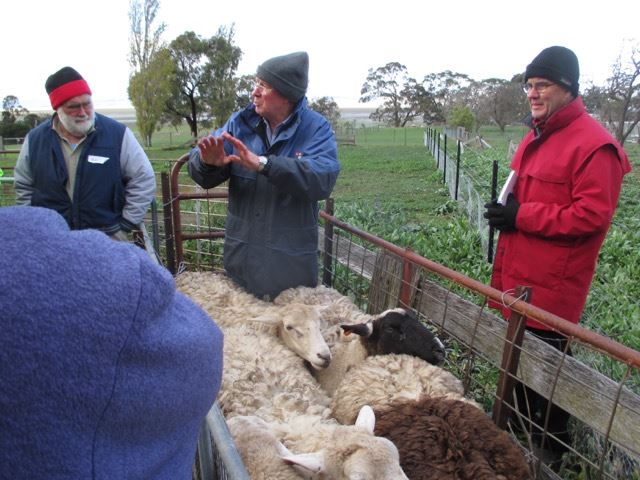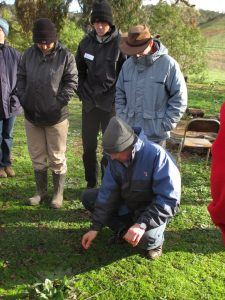Former NSW Department of Agriculture Sheep and Wool Officer, Col Langford, led an informative and interactive discussion aimed at improving the skills and knowledge of livestock managers. An outdoor practical session followed where participants learned about estimating the age of a sheep, how to catch sheep and fat scoring along with pasture and weed assessment.

South East Local Land Services District Veterinarian, Dr Kate Sawford detailed the legislative requirements for Property Identification Codes (PICS) and the National Livestock Identification System (NLIS). Did you know that all properties with stock (even just one animal) need a PIC? If you move sheep from one property to another then you need to record this in the online NLIS.
There was also a discussion about drenching, sheep diseases and routine management of sheep. The WormBoss website is a good resource for finding out managing intestinal worms in sheep to avoid unnecessary drenching.
Take home messages from the field day for participants Jennie and Susan were:
- Sheep have lice. Just like children have nits. So don’t buy “lousy” sheep. Check before you buy.
- In this region it is a good idea to supplementary feed pregnant ewes over winter. In June and July the pasture hardly grows at all and this is the time when pregnant ewes most need to maintain their weight.
- Sheep pellets are the equivalent of convenience food for sheep. While they use grains in their manufacture, they have lower nutritional value than grains and cost more to provide the same amount of energy to the sheep. You can’t even rely on them to use the same recipe every time so you should introduce each new batch slowly. You can use the by-products from malt whiskey distilling to supplement the feeding of your sheep. A wee dram of feed introduced slowly over two weeks will get them used to the taste.
- Dorper lambs can be very good at jumping.
- Fat score 2 is a very bony sheep. Fat score 3 is just right. It’s not hard to learn to take the fat score of sheep. If you cook a steak using the palm of your hand to test how well it’s cooked you can score a sheep.
- The best way to help with lambing is to keep the ewes at fat score 3 throughout their pregnancy. It’s true. All breeds can have easy births. Just like breeders advertise. It’s all down to the shepherd. A well-managed pregnant ewe will usually have an easy birth.
- You can have sheep and still have a life. It’s all down to planning. A yearly management calendar will let you know what needs to be done and when. You can then plan a holiday.

Resources
- Farm biosecurity measures can protect your property from the entry of pests and diseases and can save property owners time and money managing their stock. See www.farmbiosecurity.com.au
- Information about PICs and South East Local Land Services information and advice can be obtained from southeast.lls.nsw.gov.au/livestock. Your local district veterinarian at South East Local Land Services can also provide you with information and advice on managing worms in your flock. There are some key measures that landholders can take to manage worms in their flocks including buying worm resistant rams, providing adequate nutrition particularity to pregnant ewes, doing regular worm counts and rotating drench types. See www.wormboss.com.au
- Emergency Animal Disease Watch Hotline: 1800 675 888
- The Tocal Agricultural College publishes a series of booklets designed to assist you in managing your enterprise. You can order the Sheep Agskills and Fencing Agskills booklets on line at www.tocal.nsw.edu.au/publications
This field day was made possible by funding from the National Landcare Programme, from the Australian Government and support from South East Local Land Services.